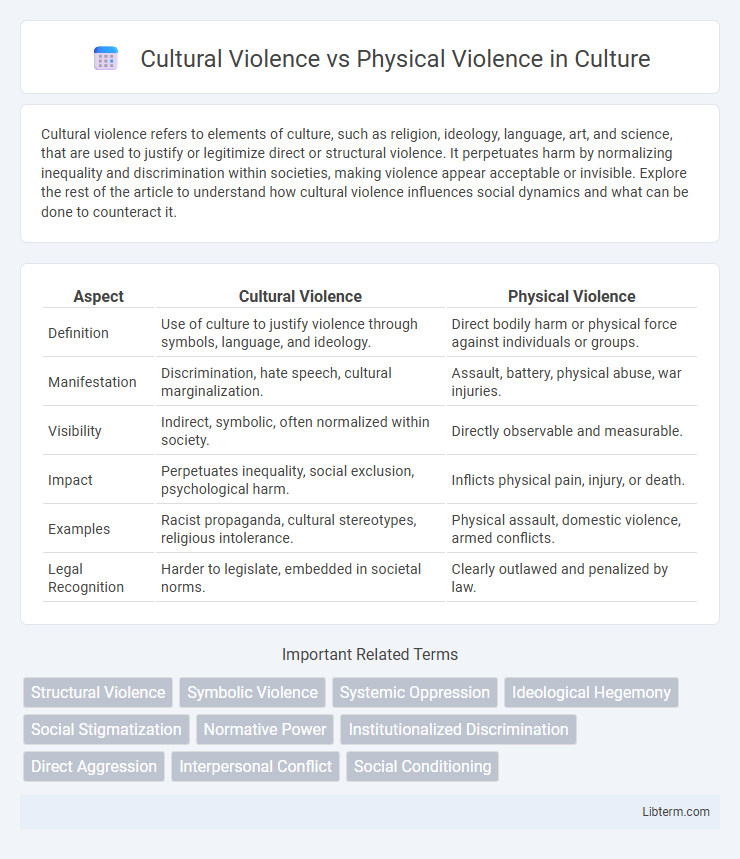Cultural violence refers to elements of culture, such as religion, ideology, language, art, and science, that are used to justify or legitimize direct or structural violence. It perpetuates harm by normalizing inequality and discrimination within societies, making violence appear acceptable or invisible. Explore the rest of the article to understand how cultural violence influences social dynamics and what can be done to counteract it.
Table of Comparison
| Aspect | Cultural Violence | Physical Violence |
|---|---|---|
| Definition | Use of culture to justify violence through symbols, language, and ideology. | Direct bodily harm or physical force against individuals or groups. |
| Manifestation | Discrimination, hate speech, cultural marginalization. | Assault, battery, physical abuse, war injuries. |
| Visibility | Indirect, symbolic, often normalized within society. | Directly observable and measurable. |
| Impact | Perpetuates inequality, social exclusion, psychological harm. | Inflicts physical pain, injury, or death. |
| Examples | Racist propaganda, cultural stereotypes, religious intolerance. | Physical assault, domestic violence, armed conflicts. |
| Legal Recognition | Harder to legislate, embedded in societal norms. | Clearly outlawed and penalized by law. |
Defining Cultural Violence
Cultural violence refers to aspects of culture, such as religion, ideology, language, or art, that are used to justify or legitimize direct or structural violence, creating an environment where physical violence is deemed acceptable or normal. Unlike physical violence, which involves bodily harm or force, cultural violence operates on an intangible level by shaping beliefs, values, and social norms that support and perpetuate inequality and aggression. Understanding cultural violence is essential for addressing root causes of conflict, as it underpins the acceptance and perpetuation of physical violence within societies.
Understanding Physical Violence
Physical violence involves the intentional use of force causing bodily harm, injury, or trauma to individuals, distinguishing it clearly from cultural violence, which manifests through symbolic acts or social structures that justify or perpetuate harm. Understanding physical violence requires recognizing its direct impact on victims, including visible injuries, psychological trauma, and immediate threat to safety. Data from the World Health Organization indicates that physical violence contributes significantly to global injury rates and mortality, emphasizing the need for targeted prevention and intervention strategies.
Key Differences Between Cultural and Physical Violence
Cultural violence involves beliefs, symbols, and structures that justify or legitimize direct or structural violence, often manifesting through language, norms, and social institutions. Physical violence refers to the actual use of physical force causing harm or injury to individuals, such as assault, battery, or war. The key difference lies in cultural violence being symbolic and indirect, shaping attitudes and enabling physical violence, whereas physical violence is the tangible, immediate act of causing bodily harm.
Historical Contexts of Cultural Violence
Cultural violence refers to the symbolic sphere of culture, encompassing religion, ideology, language, art, and science that legitimizes and normalizes direct or structural violence throughout history. In historical contexts, cultural violence has been instrumental in justifying slavery, colonialism, and ethnic cleansing by shaping societal norms and values that dehumanize certain groups. These ideologies perpetuate systemic discrimination and conflict, embedding violence within cultural narratives and institutions.
Manifestations of Physical Violence in Society
Manifestations of physical violence in society include acts such as assault, domestic abuse, armed conflict, and police brutality, which result in tangible bodily harm or death. These violent acts often leave visible scars on victims and can be quantified statistically through crime reports and health records. Physical violence disrupts social order, instills fear, and can lead to long-term psychological trauma and community destabilization.
The Role of Media in Perpetuating Cultural Violence
Media plays a critical role in perpetuating cultural violence by normalizing discriminatory stereotypes and reinforcing social inequalities through biased representation. News outlets, films, and social media platforms often propagate harmful narratives that legitimize prejudice against marginalized groups, embedding these beliefs deeply within societal consciousness. This continuous exposure influences public perception, making cultural violence an insidious form of aggression that sustains systemic oppression alongside physical violence.
Psychological Impact: Cultural vs Physical Harm
Cultural violence inflicts deep psychological harm by undermining identity, values, and social cohesion, often leading to long-term trauma and a sense of alienation. Physical violence causes immediate psychological effects such as fear, anxiety, and post-traumatic stress disorder (PTSD), which may persist or evolve into chronic mental health issues. Both forms of violence disrupt individuals' well-being, but cultural violence targets the collective psyche, embedding trauma within community structures and cultural narratives.
Cultural Violence as a Precursor to Physical Violence
Cultural violence, characterized by entrenched beliefs, norms, and ideologies that legitimize harm, acts as a precursor to physical violence by creating an environment that justifies or normalizes aggression. This form of violence sustains underlying prejudices and discriminatory practices, which can escalate into direct physical harm against individuals or groups. Understanding cultural violence is essential for addressing root causes and preventing the manifestation of physical violence in societies.
Strategies to Address and Prevent Both Forms of Violence
Addressing and preventing cultural violence requires education that promotes tolerance, inclusivity, and the dismantling of harmful stereotypes embedded in cultural norms and institutions. Preventing physical violence involves implementing community-based intervention programs, enforcing strict legal measures, and providing support services for victims to break cycles of aggression. Combining restorative justice practices with policy reforms enhances the effectiveness of strategies targeting both cultural and physical violence in society.
Building Societies Resilient to Violence
Cultural violence, embedded in societal norms and values, legitimizes and perpetuates physical violence by normalizing harm and inequality, making it crucial to address for building resilient societies. Strategies that promote education, inclusivity, and critical reflection on cultural narratives effectively disrupt the cycle of violence by challenging underlying biases and prejudices. Strengthening community engagement and institutional accountability fosters environments where peaceful conflict resolution and social cohesion can thrive, enhancing resilience against both cultural and physical violence.
Cultural Violence Infographic

 libterm.com
libterm.com